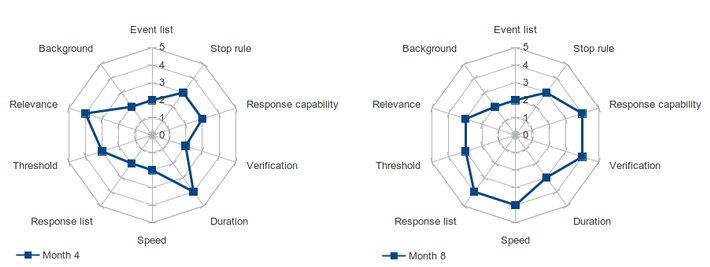
Copyright © Erik Hollnagel 2016
All Rights Reserved.
Resilience Assessment Grid (RAG)
(This page provides a brief overview of the RAG. A more detailed description can be found here.)
Introduction
A system is said to perform in a manner that is resilient when it can sustain required operations under both expected and unexpected conditions by adjusting its functioning prior to, during, or following events (changes, disturbances, and opportunities). Whereas current safety management (Safety-I) focuses on reducing the number of adverse outcomes by preventing adverse events, Resilience Engineering (RE) looks for ways to enhance the ability of systems to succeed under varying conditions (Safety-II). It is therefore necessary to understand what this ability really means, since it clearly is not satisfactory just to call it ‘resilience’.
The Four Basic Potentials for Resilient Performance
The definition of resilient performance can be made more concrete by considering what makes resilient performance possible. Since resilient performance is possible for most, if not all, systems, the explanation must refer to something that is independent of any specific domain. Resilience engineering has proposed the following four basic potentials:
- The potential to respond. Knowing what to do, or being able to respond to regular and irregular changes, disturbances, and opportunities by activating prepared actions or by adjusting current mode of functioning.
- The potential to monitor. Knowing what to look for, or being able to monitor that which is or could seriously affect the system’s performance in the near term – positively or negatively. The monitoring must cover the system’s own performance as well as what happens in the environment.
- The potential to learn. Knowing what has happened, or being able to learn from experience, in particular to learn the right lessons from the right experience.
- The potential to anticipate. Knowing what to expect, or being able to anticipate developments further into the future, such as possible disruptions, novel demands or constraints, new opportunities, or changing operating conditions.
The Interdependence of the Potentials
The four potentials are clearly not independent of each other. For example, the potential to respond can benefit from, and perhaps even requires, the potential to monitor. Similarly, the potential to learn is likewise needed to improve the potentials to monitor and to respond. The four potentials can be seen as functions, and understanding how these functions are coupled is obviously essential for managing them. This will in each specific case require a description of the interdependence of the potentials that considers the nature of the activities and the operating conditions. Since the potentials can be seen as functions, it is possible to use the FRAM to do that.
A FRAM model of the four potentials as generic functions is shown below. It shows that the four potentials depend on each other, which means that it is necessary to take these dependencies into account when trying to improve a specific potential. The model below is too simple to be of practical value, but a more detailed model - even on a generic level - can easily be developed.

Assessing the Potentials for Resilient Performance
Since resilience refers to to something that the system does rather than to something that the system has, it is not meaningful to propose a single or simple ‘measurement of resilience’ or to refer to 'levels of resilience'. But it is possible to consider the extent to which each of the four potentials that provide the basis for resilient performance are present in or supported by the system. The RAG uses four sets of questions to determine how well a system performs on each of the four basic potentials. Each question is answered using a Likert-type scale, and taken together the answers provide a profile of the system's potentials for resilient performance. (The questions can of course be answered using other sociometric techniques.) Resilience engineering proposes a set of generic questions for each potential. These questions must however be tailored to the specific application before being used.
The RAG profile, the answers to the four sets of questions, does not provide an absolute rating of a system's potentials for resilient performance. But several RAG profiles can be compared to look for differences, that in turn can be used as the basis for managing the system and following the consequences of planned interventions. The differences are easy to see if the asnwers are rendered graphically using, e.g., a radar chart.
One way of doing that is to use the RAG repeatedly for the same group of respondents, to see if there are any changes in the answers they give. A (fictive) example is provided by the two profiles (for the ability to learn) shown below. The radar chart makes it easy to see where changes have happened, and also to decide where changes should happen.

Another way of doing that is to use the RAG for different groups of respondents - either just once or repeatedly. This will show if there are any differences in how groups of respondents rate a given ability. An example of that is provided by the profiles shown below. The radar chart is based on actual data from a major organisation. Even though it for reasons of confidentiality is impossible to reveal the specific questions or identify the category of employees in each group of responders, the radar chart clearly shows that the answers for some questions could be widely different.
.jpg)
Practical guidance for using the RAG
There are five important points to remember when using the RAG.
- Develop a tailored set of diagnostic questions for the organisation. This must be based on a solid experience with how the organisation functions. Such experience can be obtained by using a focus group, a discussion group, or something similar. When developing the diagnostic questions it is also important to agree on the answer categories. If there are already known issues or problems with how an organisation functions, try to include these under one of the four potentials.
- Develop a description or model of the mutual dependencies among the four potentials. This is necessary both to interpret that data collected by the RAG and to develop effective responses (remedial actions). Such a representation or model must be specific to the organisation being managed. While it is possible to suggest a general model as a starting point, the model must be tailored to the actual organisation. More importantly, the model must express not only the couplings between the four potentials but also how the four potentials depend on the more detailed functions that are addressed by the diagnostic questions.
- Apply the RAG to the respondents, i.e., to (a subset of) the people who actually do the work. Collate the results and present them to stakeholders and respondents – and to the organisation as a whole. Discuss the conclusions and where changes are needed. Design remedial actions to bring about the changes.
- Try to work with a stable set of respondents, so that it is the same people who provide the answers for a series of assessments. The purpose of getting answers to the RAG is not to produce a distribution of attitudes and views among the respondents, but rather to recognise the common view they represent.
- Be prepared to use the RAG in the long term, and to make repeated assessments rather than a single measurement or rating. Managing and changing how an organisation performs, regardless of the type of performance or the criterion, must be done continuously over an extended period of time.
The RAG in practice
The RAG has been used in practice in a number of cases in, e.g., railways, off-shore, health care, and radiation protection. While there is no comprehensive list of practical examples, a Google Scholar search shows at least some of them. While interested readers are encouraged to do a search themselves (and share the results with me if possible), some examples are provided here:
Aaen-Stockdale, C. (2014). Oil and gas, technology and humans: assessing the human factors of technological change. Ergonomics, 57(6), 956-957.
Apneseth, K. (2010). Resilience in integrated planning. M.Sc. Thesis, Norwegian University of Science and Technology.
The Australian Radiation Protection and Nuclear Safety Agency (ARPANSA) has included the RAG as part of their holistic safety guidelines.
Ljunberg, D. & Lundh, V. (2013). Resilience Engineering within ATM - Development, adaption, and application of the Resilience Analysis Grid (RAG). University of Linköping, LiU-ITN-TEK-G--013/080--SE.
(Last update 2016-03-11. To be continued ...)